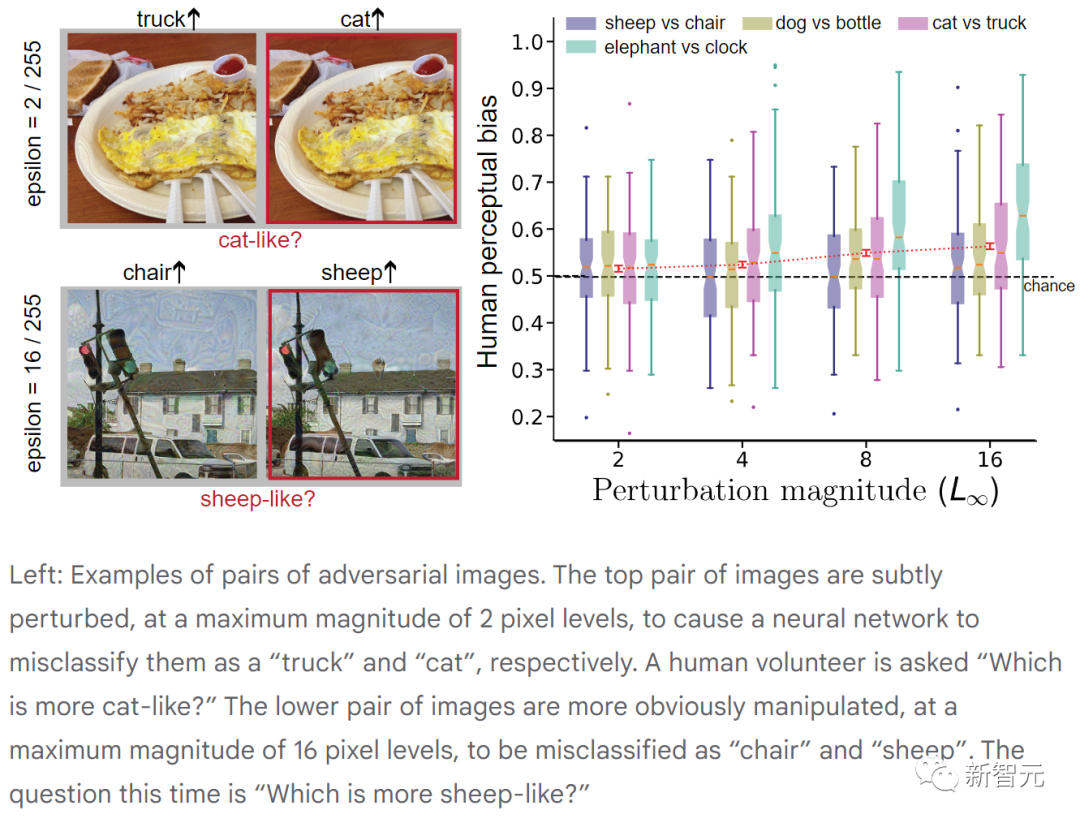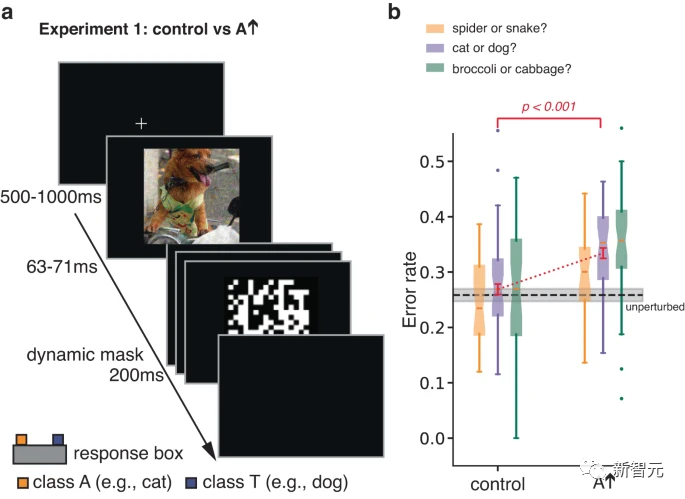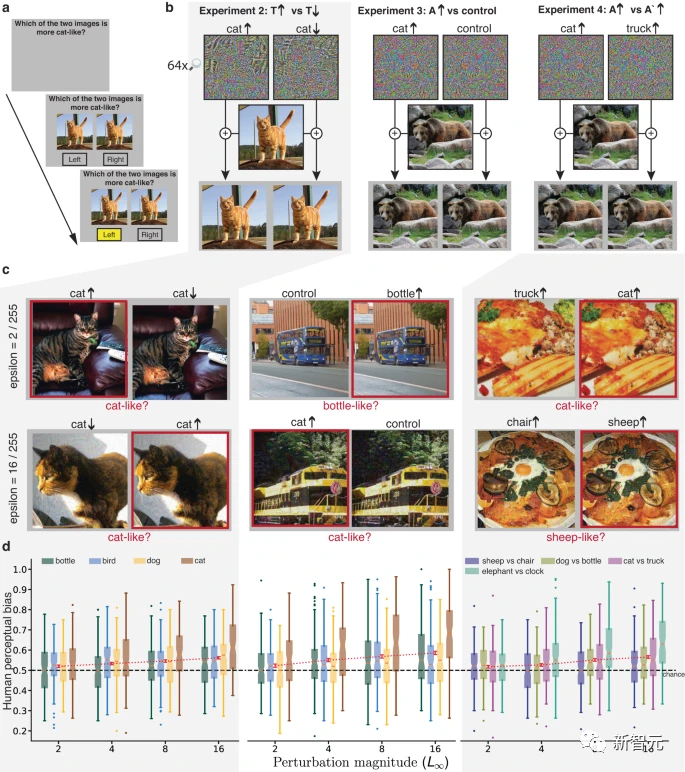 Technology peripherals
Technology peripherals
 AI
AI
 Google DeepMind research found that adversarial attacks can affect the visual recognition of humans and AI, mistaking a vase for a cat!
Google DeepMind research found that adversarial attacks can affect the visual recognition of humans and AI, mistaking a vase for a cat!
Google DeepMind research found that adversarial attacks can affect the visual recognition of humans and AI, mistaking a vase for a cat!
What is the relationship between human neural network (brain) and artificial neural network (ANN)?
A teacher once compared it this way: It’s like the relationship between a mouse and Mickey Mouse.
Real-life neural networks are powerful, but completely different from the way humans perceive, learn and understand.
For example, ANNs exhibit vulnerabilities not usually found in human perception, and they are susceptible to adversarial perturbations.
An image may only need to modify the values of a few pixels, or add some noise data,
From a human perspective, observe There is no difference, and for the image classification network, it will be recognized as a completely unrelated category.
However, the latest research from Google DeepMind shows that our previous view may be wrong!
Even subtle changes in digital images can affect human perception.
In other words, human judgment can also be affected by such adversarial perturbations.

Paper address: https://www.nature.com/articles/s41467-023-40499-0
This article by Google DeepMind was published in Nature Communications.
The paper explores whether humans might also exhibit sensitivity to the same perturbations under controlled testing conditions.
Through a series of experiments, the researchers proved this.
At the same time, this also shows the similarities between human and machine vision.
Adversarial images
Adversarial images are subtle changes to an image that cause the AI model to misclassify the image content, - This type of deliberate deception is called an adversarial strike.
For example, an attack could be targeted to cause an AI model to classify a vase as a cat, or as anything other than a vase.

The above figure shows the process of adversarial attack (for the convenience of human observation, the random perturbations in the middle are exaggerated).
In digital images, each pixel in the RGB image has a value between 0-255 (at 8-bit depth), and the value represents the intensity of a single pixel.
For adversarial attacks, the attack effect may be achieved by changing the pixel value within a small range.
In the real world, adversarial attacks on physical objects may also be successful, such as causing a stop sign to be mistakenly recognized as a speed limit sign.
So, for security reasons, researchers are already working on ways to defend against adversarial attacks and reduce their risks.
Adversarial effects on human perception
Previous research has shown that people may be sensitive to large-amplitude image perturbations that provide clear shape cues.
However, what impact do more nuanced adversarial attacks have on humans? Do people perceive perturbations in images as harmless random image noise, and does it affect human perception?
To find out, researchers conducted controlled behavioral experiments.
First a series of raw images are taken and two adversarial attacks are performed on each image to produce multiple pairs of perturbed images.
In the animated example below, the original image is classified by the model as a "vase".
Due to the adversarial attack, the model misclassified the two disturbed images as "cat" and "truck" with high confidence.

Next, human participants were shown the two images and asked a targeted question: Which image was more like a cat? ?
Although neither photo looked like a cat, they had to make a choice.
Often, subjects believe that they have made random choices, but is this really the case?
If the brain was insensitive to subtle adversarial attacks, subjects would choose each picture 50% of the time.
However, experiments have found that the selection rate (that is, human perception bias) is actually higher than chance (50%), and in fact the adjustment of picture pixels is very small.
From the participant's perspective, it feels like they are being asked to differentiate between two nearly identical images. However, previous research has shown that people use weak perceptual signals when making choices - even though these signals are too weak to convey confidence or awareness.
In this example, we might see a vase, but some activity in the brain tells us that it has the shadow of a cat.

#The above figure shows pairs of adversarial images. The top pair of images are subtly perturbed, with a maximum amplitude of 2 pixels, causing the neural network to misclassify them as "truck" and "cat" respectively. (Volunteers were asked "Which one is more like a cat?")
The disturbance in the lower pair of images is more obvious, with a maximum amplitude of 16 pixels, and was incorrectly classified by the neural network as " "Chair" and "Sheep". (This time the question was "Which one is more like a sheep?")
In each experiment, participants reliably chose the answer to the target question more than half the time. Confrontation images. While human vision is not as susceptible to adversarial perturbations as machine vision, these perturbations can still bias humans in favor of decisions made by machines.
If human perception can be affected by adversarial images, then this will be a new but critical security issue.
This requires us to conduct in-depth research to explore the similarities and differences between the behavior of artificial intelligence visual systems and human perception, and to build safer artificial intelligence systems.
Paper details
The standard procedure for generating adversarial perturbations starts with a pre-trained ANN classifier that maps RGB images to A probability distribution over a fixed set of classes.
Any changes to the image (such as increasing the red intensity of a specific pixel) will produce a slight change in the output probability distribution.
Adversarial images are searched (gradient descent) to obtain a perturbation of the original image that causes the ANN to lower the probability of being assigned to the correct class (non-targeted attack) or assign a high probability Give certain designated alternative categories (targeted attacks).
To ensure that the perturbation does not deviate too far from the original image, the L (∞) norm constraint is often applied in the adversarial machine learning literature, specifying that no pixel can deviate from its original value by more than ±ε, ε is usually much smaller than the [0–255] pixel intensity range.
This constraint applies to pixels in each RGB color plane. Although this limitation does not prevent individuals from detecting changes in the image, by appropriately choosing ε, the main signal indicating the original image category remains mostly intact in the perturbed image.
Experiments
In the original experiment, the authors studied human response to brief, occluded adversarial images. Categorize responses.
By limiting exposure time to increase classification errors, the experiment was designed to increase an individual's sensitivity to aspects of a stimulus that might not otherwise influence classification decisions.
An adversarial perturbation is performed on the image of the real class T. By optimizing the perturbation, the ANN tends to misclassify the image as A. Participants were asked to make a forced choice between T and A.

The researchers also tested participants on control images, which were obtained in condition A by flipping them top-down. Adversarial perturbation image formation.
This simple transformation breaks the pixel-to-pixel correspondence between the adversarial perturbation and the image, largely eliminating the impact of the adversarial perturbation on the ANN, while retaining the perturbation specification and other Statistical data.
The results showed that participants were more likely to judge the perturbed image as category A compared to the control image.
Experiment 1 above used a brief masking demonstration to limit the influence of the original image category (primary signal) on the response, thereby revealing sensitivity to adversarial perturbations (subordinate signal) .
The researchers also designed three other experiments with the same goals, but avoided the need for large-scale perturbations and limited-exposure viewing.
In these experiments, the dominant signal in the image does not systematically guide response selection, allowing the influence of the subordinate signal to emerge.

In each experiment, a nearly identical pair of unmasked stimuli was presented and remained visible until a response was selected. The pair of stimuli have the same dominant signal, they are both modulations of the same underlying image, but have different slave signals. Participants were asked to select images that more closely resembled instances of the target category.
In Experiment 2, both stimuli were images belonging to the T category. One of them was perturbed, and the ANN predicted that it was more like the T category. The other was perturbed and was predicted to be Not even like a T category.
In Experiment 3, the stimulus is an image belonging to the real category T, one of which is perturbed to change the classification of the ANN, making it closer to the target adversarial category A, and the other One uses the same perturbation but flipped left and right as a control condition.
The effect of this control is to preserve the norm and other statistics of the perturbation, but it is more conservative than the control in Experiment 1, because the left and right sides of the image may have more characteristics than the upper and lower parts of the image. More similar statistics.
The pair of images in Experiment 4 are also modulations of the real category T, one is perturbed to be more like category A, and the other is more like category 3. Trials alternated between asking participants to choose an image that was more like Category A, or an image that was more like Category 3.
In Experiments 2-4, the human perceptual bias of each image was significantly positively correlated with the bias of the ANN. Perturbation amplitudes ranged from 2 to 16, which are smaller than perturbations previously studied on human participants and similar to those used in adversarial machine learning studies.
Surprisingly, perturbations of even 2 pixel intensity levels are enough to reliably affect human perception.

The strength of Experiment 2 is that it requires participants to make intuitive judgments (e.g., which of two perturbed cat images is more like a cat) ;
However, Experiment 2 allows adversarial perturbations to make images more or less cat-like simply by sharpening or blurring them.
The advantage of Experiment 3 is that all statistics of the perturbations compared are matched, not just the maximum amplitude of the perturbation.
However, matching perturbation statistics does not ensure that the perturbation is equally perceptible when added to the image, and therefore, participants may make choices based on image distortion.
The strength of Experiment 4 is that it demonstrates that participants are sensitive to the questions being asked, as the same image pairs produced systematically different responses depending on the question asked.
However, Experiment 4 asked participants to answer a seemingly absurd question (e.g., which of two omelet images looks more like a cat?), leading to question interpretation Variability of manner.
Taken together, Experiments 2-4 provide converging evidence that even very small perturbations with unlimited viewing time can have a strong impact on AI networks The subordinate confrontation signal will also affect human perception and judgment in the same direction.
Furthermore, extending the observation time (naturally perceived environment) is key for adversarial perturbations to have real consequences.
The above is the detailed content of Google DeepMind research found that adversarial attacks can affect the visual recognition of humans and AI, mistaking a vase for a cat!. For more information, please follow other related articles on the PHP Chinese website!

Hot AI Tools

Undresser.AI Undress
AI-powered app for creating realistic nude photos

AI Clothes Remover
Online AI tool for removing clothes from photos.

Undress AI Tool
Undress images for free

Clothoff.io
AI clothes remover

AI Hentai Generator
Generate AI Hentai for free.

Hot Article

Hot Tools

Notepad++7.3.1
Easy-to-use and free code editor

SublimeText3 Chinese version
Chinese version, very easy to use

Zend Studio 13.0.1
Powerful PHP integrated development environment

Dreamweaver CS6
Visual web development tools

SublimeText3 Mac version
God-level code editing software (SublimeText3)

Hot Topics
 1382
1382
 52
52
 Centos shutdown command line
Apr 14, 2025 pm 09:12 PM
Centos shutdown command line
Apr 14, 2025 pm 09:12 PM
The CentOS shutdown command is shutdown, and the syntax is shutdown [Options] Time [Information]. Options include: -h Stop the system immediately; -P Turn off the power after shutdown; -r restart; -t Waiting time. Times can be specified as immediate (now), minutes ( minutes), or a specific time (hh:mm). Added information can be displayed in system messages.
 What are the backup methods for GitLab on CentOS
Apr 14, 2025 pm 05:33 PM
What are the backup methods for GitLab on CentOS
Apr 14, 2025 pm 05:33 PM
Backup and Recovery Policy of GitLab under CentOS System In order to ensure data security and recoverability, GitLab on CentOS provides a variety of backup methods. This article will introduce several common backup methods, configuration parameters and recovery processes in detail to help you establish a complete GitLab backup and recovery strategy. 1. Manual backup Use the gitlab-rakegitlab:backup:create command to execute manual backup. This command backs up key information such as GitLab repository, database, users, user groups, keys, and permissions. The default backup file is stored in the /var/opt/gitlab/backups directory. You can modify /etc/gitlab
 How to check CentOS HDFS configuration
Apr 14, 2025 pm 07:21 PM
How to check CentOS HDFS configuration
Apr 14, 2025 pm 07:21 PM
Complete Guide to Checking HDFS Configuration in CentOS Systems This article will guide you how to effectively check the configuration and running status of HDFS on CentOS systems. The following steps will help you fully understand the setup and operation of HDFS. Verify Hadoop environment variable: First, make sure the Hadoop environment variable is set correctly. In the terminal, execute the following command to verify that Hadoop is installed and configured correctly: hadoopversion Check HDFS configuration file: The core configuration file of HDFS is located in the /etc/hadoop/conf/ directory, where core-site.xml and hdfs-site.xml are crucial. use
 How is the GPU support for PyTorch on CentOS
Apr 14, 2025 pm 06:48 PM
How is the GPU support for PyTorch on CentOS
Apr 14, 2025 pm 06:48 PM
Enable PyTorch GPU acceleration on CentOS system requires the installation of CUDA, cuDNN and GPU versions of PyTorch. The following steps will guide you through the process: CUDA and cuDNN installation determine CUDA version compatibility: Use the nvidia-smi command to view the CUDA version supported by your NVIDIA graphics card. For example, your MX450 graphics card may support CUDA11.1 or higher. Download and install CUDAToolkit: Visit the official website of NVIDIACUDAToolkit and download and install the corresponding version according to the highest CUDA version supported by your graphics card. Install cuDNN library:
 Centos install mysql
Apr 14, 2025 pm 08:09 PM
Centos install mysql
Apr 14, 2025 pm 08:09 PM
Installing MySQL on CentOS involves the following steps: Adding the appropriate MySQL yum source. Execute the yum install mysql-server command to install the MySQL server. Use the mysql_secure_installation command to make security settings, such as setting the root user password. Customize the MySQL configuration file as needed. Tune MySQL parameters and optimize databases for performance.
 Detailed explanation of docker principle
Apr 14, 2025 pm 11:57 PM
Detailed explanation of docker principle
Apr 14, 2025 pm 11:57 PM
Docker uses Linux kernel features to provide an efficient and isolated application running environment. Its working principle is as follows: 1. The mirror is used as a read-only template, which contains everything you need to run the application; 2. The Union File System (UnionFS) stacks multiple file systems, only storing the differences, saving space and speeding up; 3. The daemon manages the mirrors and containers, and the client uses them for interaction; 4. Namespaces and cgroups implement container isolation and resource limitations; 5. Multiple network modes support container interconnection. Only by understanding these core concepts can you better utilize Docker.
 Centos8 restarts ssh
Apr 14, 2025 pm 09:00 PM
Centos8 restarts ssh
Apr 14, 2025 pm 09:00 PM
The command to restart the SSH service is: systemctl restart sshd. Detailed steps: 1. Access the terminal and connect to the server; 2. Enter the command: systemctl restart sshd; 3. Verify the service status: systemctl status sshd.
 How to view GitLab logs under CentOS
Apr 14, 2025 pm 06:18 PM
How to view GitLab logs under CentOS
Apr 14, 2025 pm 06:18 PM
A complete guide to viewing GitLab logs under CentOS system This article will guide you how to view various GitLab logs in CentOS system, including main logs, exception logs, and other related logs. Please note that the log file path may vary depending on the GitLab version and installation method. If the following path does not exist, please check the GitLab installation directory and configuration files. 1. View the main GitLab log Use the following command to view the main log file of the GitLabRails application: Command: sudocat/var/log/gitlab/gitlab-rails/production.log This command will display product



